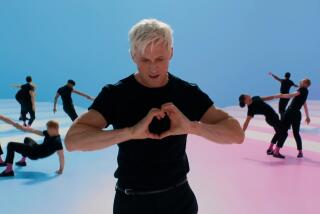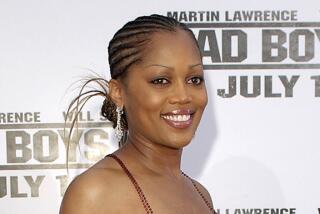From ‘Deadpool’ to ‘Hamilton’ to ‘Stranger Things,’ this was the year of pop-culture collisions
- Share via
Without someone deciding to attempt a smart — sometimes unlikely — combination, much of what we admire wouldn’t exist.
Absent DeAndre Jordan, Chris Paul would just be lobbing to empty air. The latest Korean American fusion dish would be a lonely hamburger dreaming longingly of kimchi slaw. The heavenly Labradoodle would be but a mythical creature.
But rarely has so much disparateness been brought together so frequently, or so effectively, as in entertainment circa 2016. This has been the year of the combination — or, more accurately, the collision. Creators took ingredients from remote places, studied them closely, then ground them together. In all that genre-mashing and form-smashing, concoctions emerged that were never thought possible.
This was a good thing.
Well, mostly a good thing.
The first months of the movie year yielded a pair of such phenomena. In February, “Spotlight,” from Tom McCarthy and his writing partner Josh Singer, won the Academy Award for best picture by melding the values of traditional fictional storytelling with the diligence and social-consciousness of activist reporting. Its story of the Boston church-abuse scandals became the first modern winner of Oscar’s top prize that also was very possibly an act of journalism in its own right.
Best of 2016: The year in review »
That same month, Ryan Reynolds’ “Deadpool” offered its own improbable fusion — of the raunchy comedy and the superhero crusader. For the last decade, the two dominant film currencies have been the spandex stalwart and the blue one-liner. Director Tim Miller synthesized them in this Marvel movie, then Fox put out the result in the experimental precincts of late winter. Turns out we loved the hybrid, rewarding it with more than three-quarters of a billion dollars in worldwide box office.
The idea of bringing together forms that rarely coexist was also all over television, not least with the resurgent live musical, which in 2016 expanded to a full-fledged category on multiple networks thanks to Fox’s adaptation of “Grease” and NBC’s “Hairspray.” Meanwhile, a 1980s popcorn throwback met 21st-century streaming in Netflix’s “Stranger Things.” And rigorous documentary film became, startlingly, the stuff of episodic cable television in “O.J: Made in America.” What was on one level a TV show about a case was on another an epic piece of cinema about race.
From the minute it debuted at the Sundance Film Festival in January, director Ezra Edelman took pains to note that while the medium and installment-format of “O.J.” may say television, the ambition and execution bellowed cinema. ESPN then underscored these collisionary aims — and complicated the lives of awards voters — by qualifying the piece for the Academy Awards. Which means the thing no one could quite define could win an Oscar and an Emmy in the same year.
Television and film had, for a long time, been set up as parallel lines, running together yet never intersecting. But recent years of crossover — all those directors and stars moving between the platforms — had now reached its natural end point. Here was a work that could somehow at the same time be anointed the best movie and best TV series of the year.
Hollywood is built on melding foreign elements. The addition of sound to moving pictures transformed movies, and the history of entertainment is one of integration into new venues— from the movie palaces to the home, from the home to pocket-size mobile devices.
But something new was in the air this year — a desire to experiment, yes, but also an almost dare-like attempt to try new Hydras, to see if what had never been brought together suddenly could marry. It was as if entertainment had collectively made the postmodern acknowledgment that pure originality was impossible, so the only thing left to do was take what already existed and create new permutations from them.
As audience members, it should be said, we made a decision too — to open ourselves up to these experiments, our jaundiced 21st-century feelings that we’d seen it all evaporating with the sheer novelty of the attempt, if not the outright appreciation of the result.
Nor was it just screen entertainment. Much has been rightly made of the musician deaths of 2016, a long and sad list topped by David Bowie and Prince. Both the Thin White Duke and the purple-clad one were of course kings of the collision, bringing together disparate forms of fashion and music in the same person. And although they’re no longer here, several musical personalities took the baton in their absence.
This refers not just to pop music’s ongoing collaborations of opposites — hello, Justin Bieber and Skrillex, who joined up for “Sorry” as it nestled its way into every public space in 2016 — but perhaps one of the best non-pop stories of the year, Sturgill Simpson. With his record “A Sailor’s Guide to Earth,” the songwriter’s heady lyrics about astrophysics (not to mention soul and funk touches) worked itself into the improbable genre of country music. The blend worked — most startlingly, for Grammy voters, who in December named “Sailor’s Guide” to the shortlist of albums of the year over far more traditional, non-combinative efforts.
And of course there was the quintessential musical mashing: “Lemonade.” Beyoncé in 2016 offered a mix of styles and spectacle, of genres and pageantry, as she somehow brought together reggae, country, R&B, funk, gospel, EDM — and Kendrick Lamar, James Blake and Jack White. Also, an entire film to go with it. Why collide within a medium if you can demolition derby outside it?
Even Donald Trump (what, you thought you could get through a year-end column without seeing his name?) offered a version of this, combining celebrity pitchman with presidential politics for a new and unforeseen hybrid.
There were also the more technical forms of convergence with virtual reality. The PlayStation VR or the Oculus Rift, both of which debuted in 2016, or Samsung’s Gear VR, which gained a new foothold in the year. Much of what’s available on these platforms is of the collisional variety, mixing passive viewing with active looking, as in “Notes on Blindness” a kind of VR companion to a short film that replicates the sensations of sightlessness, or “The Martian VR,” Fox’s Matt Damon spinoff that is a movie that is a video game that is a VR experience.
And then came the collision to end all collisions: “Hamilton.” Could hip-hop and Revolutionary War-era history coexist? And in a Broadway musical, no less? Few would have ever said so. But in 2016 “Hamilton” turned into a cultural landmark, winning a dozen Tony Awards and defining a teenage generation.
Ah, but where to draw the line between skillful blend and kitchen-sink detritus? Surely many who watched some of these pop-cultural combinations would ask the question, and have a case. They might point to Pitbull performing at the Grammys with Joe Perry, or to “Suicide Squad.” Combining distinct forms can be ambitious, fun, even noble. Tossing in personalities pell-mell, on the other hand, can feel like an act of cynical overstuffing. It’s “well, we didn’t know if our creation worked on its own, so we piled on more elements in the hope you’ll like one of them.” (See also under: “Batman v. Superman,” a quite-literal collision.)
Back in the technological realm, VR — fundamentally a means of combining the best of video games and cinema, of passivity and interactivity, of escapism and hyper-realism — is itself at a tipping point, implicitly posing the question of whether these many combinations can live in balance.
The last year just began scratching at these queries. The new year will yield more such clawing. Should “Groundhog Day” be on Broadway? (It will try, this spring.) Will Martin Scorsese’s typical blood ethos fit with spiritual meditation in “Silence,” rolling out and expanding in the new year? Will LCD Soundsystem, His Lord Highness Frontman DJ James Murphy the king of the savvy style-jumbling, finally bring out that elusive new record, and will it be any good? Will an ambitious VR project like Oculus’ “Dear Angelica,” which seeks to mix the melancholy of a Pixar movie with a kind of cutting-edge update of Microsoft Paint, flourish in harmony?
And with “The Hamilton Mixtape” just out and sure to land under many Christmas trees, will its underlying idea — of musicians that inspired a show now creating songs the show inspired — take off, art doubling back on itself? Could this be the year when combinations bond with other combinations?
Before you answer, or shake your head at the postmodern overload, realize that, yes, many exotic blends don’t work. Then take a look at the neighborhood Labradoodle. He is gazing lustily at something. You focus your eyes. Yes, there it is. It’s at the Puggle down the street.
On Twitter: @ZeitchikLAT
More to Read
Only good movies
Get the Indie Focus newsletter, Mark Olsen's weekly guide to the world of cinema.
You may occasionally receive promotional content from the Los Angeles Times.








